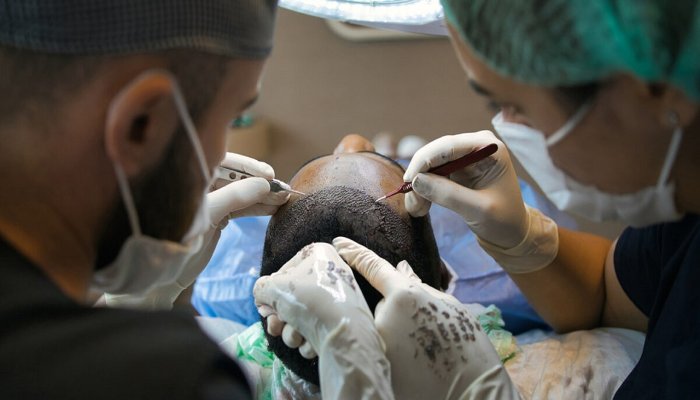There are many potential causes of hair loss, so it is essential to consult a doctor to determine the underlying cause. There are a few different tests that can be done in order to determine the cause of hair loss.
- Light microscopy:
One of the most common tests is light microscopy. This test involves looking at a sample of the hair under a microscope in order to determine if there is any damage to the hair shaft. This type of testing can be beneficial in determining if the hair loss is due to a medical condition or if it is just a normal part of the aging process.
- Blood test:

Another test that may be recommended is a blood test. A blood test may be ordered to check for specific conditions that can cause hair loss. This can help check for certain conditions, such as thyroid problems or anemia, which can contribute to hair loss. Some of the most common causes of hair loss include hormonal imbalances, thyroid problems, and nutritional deficiencies. If the blood test does not reveal any underlying medical conditions, the doctor may recommend a scalp biopsy to rule out other potential causes of hair loss.
- Scalp biopsy:
One of the most common tests is a scalp biopsy. This involves taking a small sample of tissue from the affected area of the scalp and examining it under a microscope. This can help to rule out certain conditions, such as fungal infections or autoimmune disorders. This can help to determine if the hair loss is due to a medical condition such as alopecia.
- Pull test:
One such test is the pull test. In this test, the doctor will take a small tuft of hair and gently pull on it. If more than six hairs come out, there is likely a problem with the hair follicles. This test can help determine if the hair loss is due to a medical condition or just normal shedding.
- Miniaturization test:
The miniaturization test is a test that is used to determine the cause of hair loss. This test is used to determine if hair loss is due to genetic factors. This test is performed by taking a small sample of hair from the affected area and looking at it under a microscope. If the hair follicles are smaller than average, then this is an indication of genetic hair loss. This test can help determine if the hair loss is due to a genetic condition, a medical condition, or a problem with how the hair follicles are growing.
Must Read the Related Articles:
- Where does hair loss start?
- Is hair loss from steroids permanent?
- The Truth About Postpartum Hair Loss
What are the treatments for hair loss?
There are a few different treatments for hair loss.

- Spironolactone:
One of them is spironolactone, a pill you take orally. It works by blocking the hormone that causes hair loss. It can take a few months to see results, and it’s not suitable for everyone.
- Dutasteride:
Dutasteride is a medication that is used to treat hair loss. It works by inhibiting the production of dihydrotestosterone, a hormone that is responsible for hair loss. Dutasteride is available in pill form and is taken orally. It is typically taken once a day with or without food.
- Minoxidil (Rogaine):
There are several treatments for hair loss, the most common of which is minoxidil (Rogaine). Minoxidil is a topical solution that is applied to the scalp twice daily. It can help to stimulate hair growth, but it takes time to see results. Minoxidil helps to promote hair growth by increasing blood flow to the scalp. It is thought to work by stimulating hair growth and widening hair follicles. Minoxidil is available over the counter for both men and women.
- Finasteride (Propecia):
There are several potential treatments for hair loss, depending on the underlying cause. One of the most beneficial hair loss treatments is finasteride (Propecia). Finasteride (Propecia) is a medication that is taken once daily and is thought to work by blocking the conversion of testosterone to dihydrotestosterone (DHT), and that inhibits the production of DHT, helping to prevent or slow hair loss because one common cause of hair loss is an excess of the hormone dihydrotestosterone (DHT) in the scalp.
- Hair transplant surgery:

Hair transplant surgery is a treatment for hair loss. It involves taking hair from one area of the head and transplanting it to the balding or thinning area. This can help restore hair growth and give the appearance of a fuller head. The surgery is usually done under local anesthesia and can take several hours to complete. There is typically a recovery period of a few days after the surgery, during which the transplanted area may be sore or swollen.
- Laser therapy:
Laser therapy is a new treatment for hair loss. It uses low-level laser light to stimulate hair growth. The laser light is absorbed by the cells in the scalp, which increases blood flow and promotes hair growth. This treatment is safe and effective, and it doesn’t have any side effects.
What type of hair loss can be treated?
Pattern baldness is the most common type of hair loss and can affect both men and women. It is characterized by a receding hairline and thinning of the hair on the top of the head. Pattern baldness is caused by a combination of genetic and hormonal factors. Fortunately, treatments available can help slow down or even stop the progression of pattern baldness. These include minoxidil, finasteride, and low-level laser therapy.
Conclusion:
If you’re concerned about hair loss, it’s essential to see a doctor to rule out any underlying medical conditions. Once potential medical causes have been ruled out, your doctor can help you determine the best course of action, which may include testing for nutrient deficiencies or trying different hairstyles and products. If you’re experiencing hair loss, don’t hesitate to reach out to a professional for help. If you don’t do that, this problem will become severe or cause permanent hair loss, which is very difficult to treat and costly and painful.
